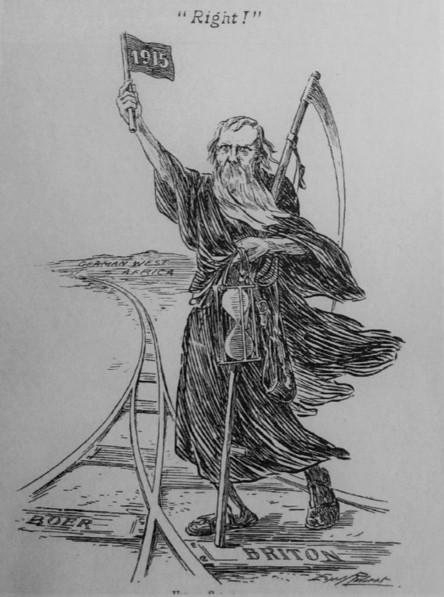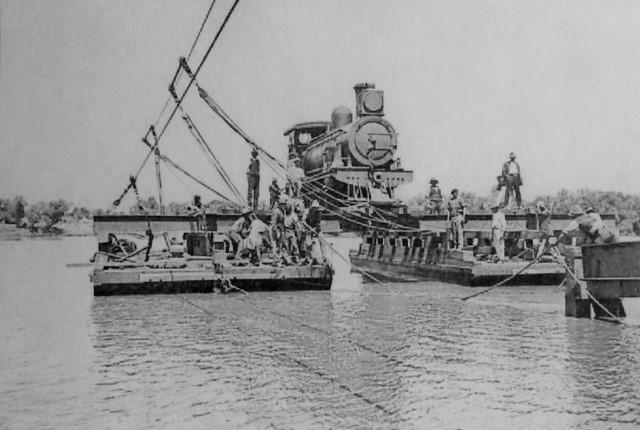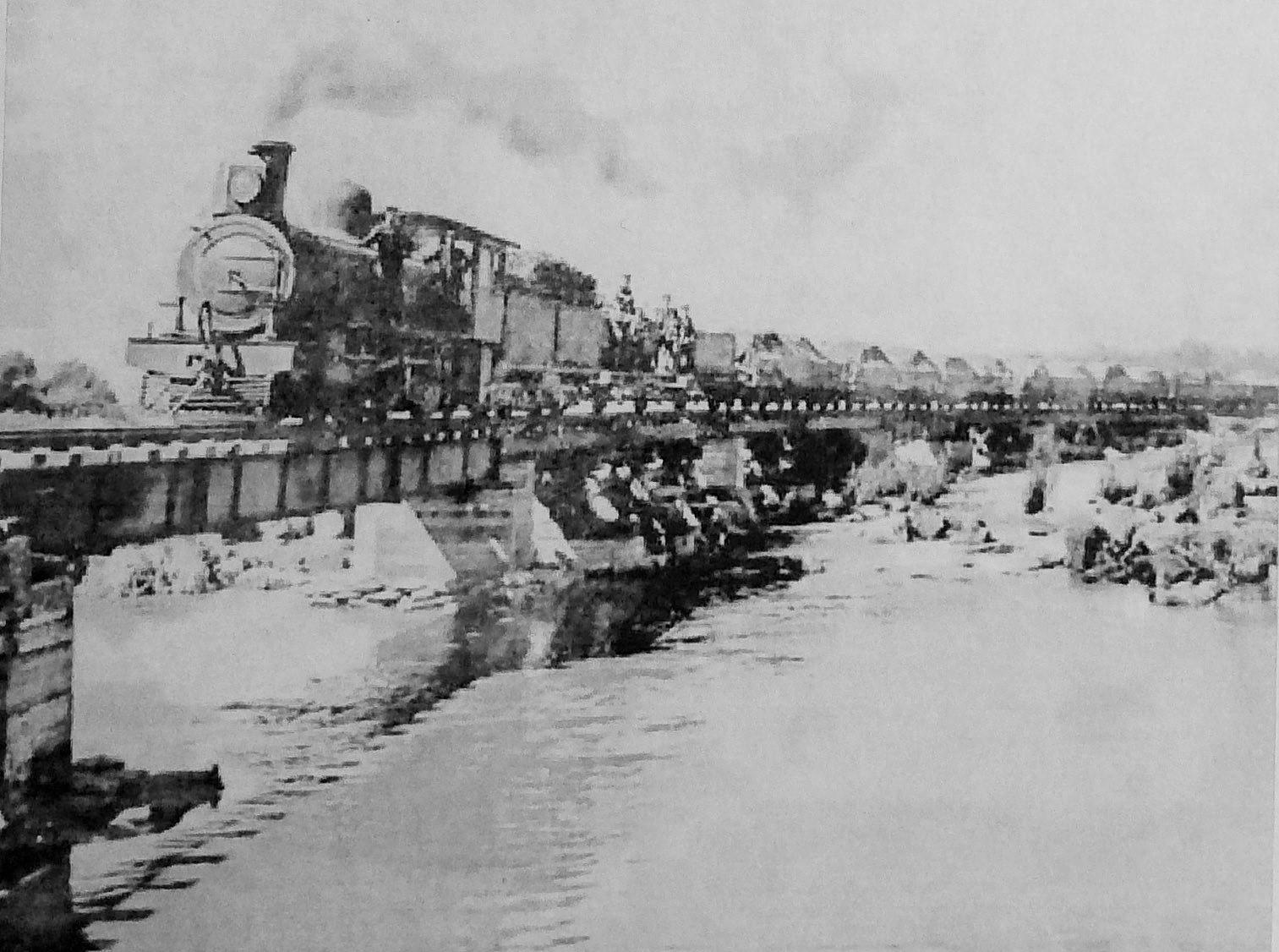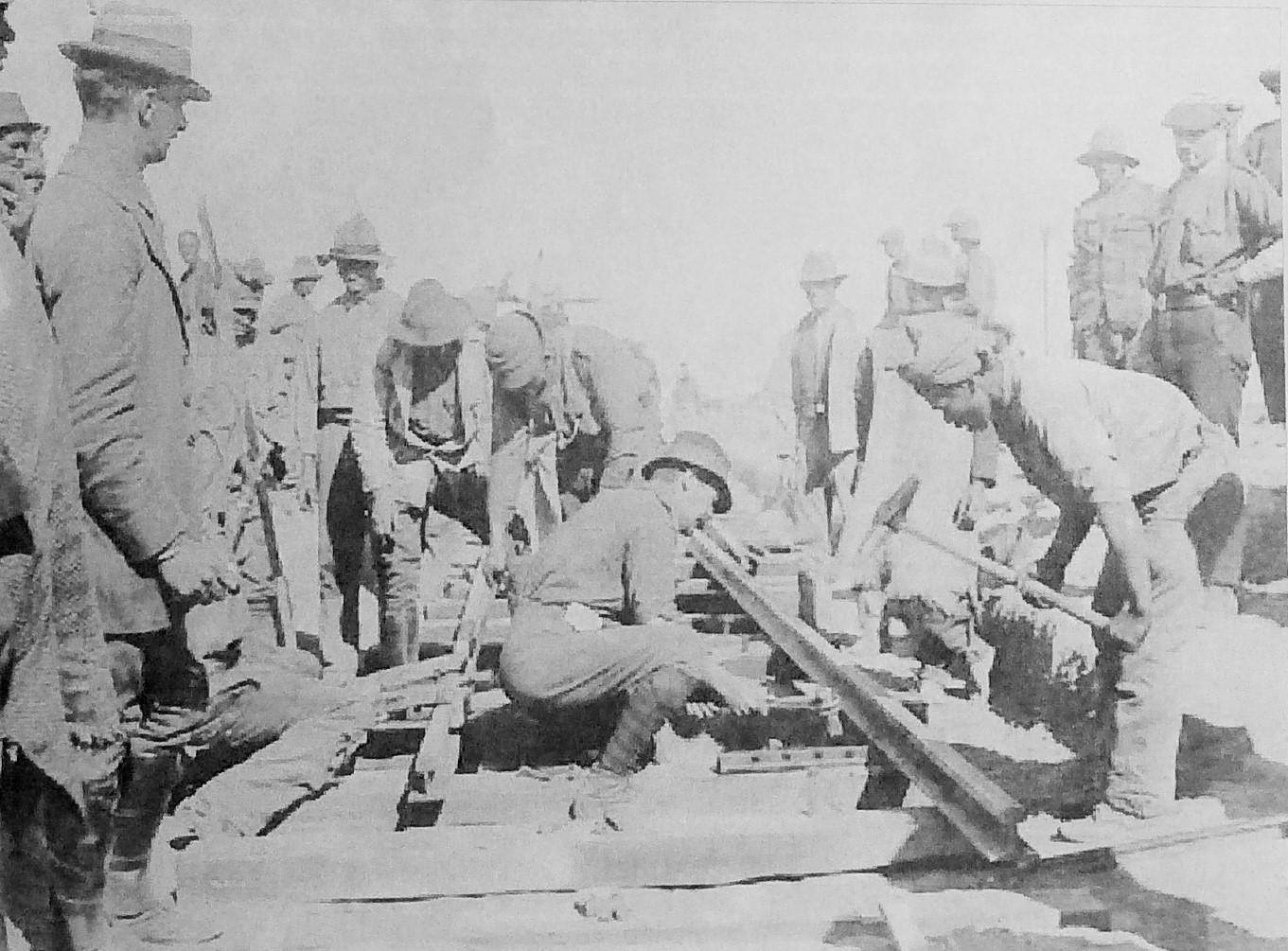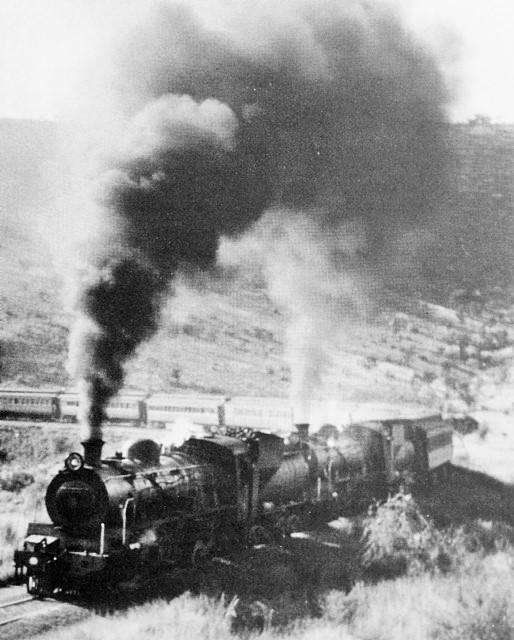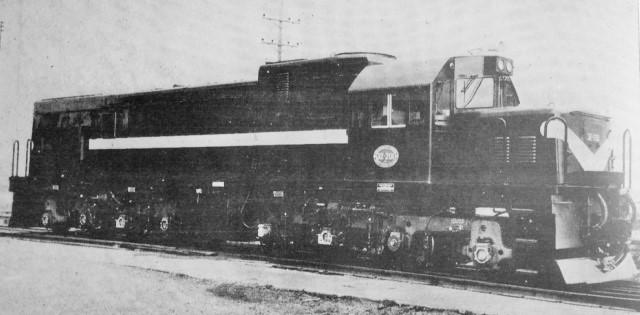Disclaimer: Any views expressed by individuals and organisations are their own and do not in any way represent the views of The Heritage Portal. If you find any mistakes or historical inaccuracies, please contact the editor.
The railway line that connects South Africa to Namibia is now 100 years old and owes its origin to the outbreak of the First World War in August 1914. The cross border stretch between Prieska, Northern Cape and Karasburg (formerly Kalkfontein), Namibia was hastily built as a military railway to give logistical support to General Louis Botha’s troops in his 1915 invasion of what was then German South West Africa (a colony twice the size of the Fatherland).
The German presence in Africa stemmed from the “Scramble for Africa” and the Berlin Conference of 1884, convened by the German Chancellor, Otto von Bismarck. The conference was ostensibly summoned to address the humanitarian concerns brought about by the Arab slave trade however it engaged itself instead in the issues of possession and occupation of land for the purpose of exploiting the natural resources of the continent. Thus Africa was carved up by the European powers with no consideration of the native people already inhabiting the land. Spheres of influence were created in order to reduce conflict between the European nations when certain land claims were in dispute. The German Empire in Africa, as of 1914, included Togoland, Cameroon, Tanganyika and South West Africa (S.W.A.), colonies that were on the coastline, however the Germans had envious eyes on the interior (the Congo and Zambesi basins) and would have taken those territories had they won the First World War (1914 -1918).
Europe was at war as of the 1st August 1914 and Britain at first was reluctant to join the fray, however by the 4th August Britain had declared war on Germany in support of France and Russia. The Union of South Africa was aligned with Britain and was asked to equip and send an expedition to occupy German South West Africa. Preparations for invasion were made immediately, and an announcement was made by the Prime Minister, Louis Botha, on 9th September 1914, at a special sitting of Parliament and a vote in its favour was carried, however the Nationalists under Barry Hertzog voted to a man against it. As mobilisation of the Commandos was in hand events took a turn for the worse when a Rebellion was started by former Boer Generals. General Koos de la Rey was shot dead, on 15th September at a police road block set up to apprehend the notorious Foster Gang, along the Main Reef Road west of Johannesburg. He was a passenger in a car, accompanied by Christiaan Beyers, that sped through the road block and the police opened fire. This act was used for propaganda against the Government by the instigators of the uprising. It was later confirmed that Beyers, the ex Commandant General of the Citizen Force (recently resigned), was the leader of the Rebels and was in fact on his way to Potchefstroom to meet with Jan Kemp and start the rebellion. The revolt was supported by De Wet, Kemp and Maritz, the latter being stationed on the border with S.W.A. and at the start of the rebellion he became a turncoat and went over to the German side taking several of his officers and men with him; those men who would not collaborate became prisoners of war. Botha and Smuts were alert to the danger of an all out civil war between the former Boer War commanders and declared Martial Law and were quick to seize the initiative and quell the insurrection, which was all over by February 1915. The Rebel leader Beyers came to an ignominious end when he was drowned, on 8th December 1914, whilst trying to cross the Vaal River in an attempt to evade government troops.
Louis Botha, the erstwhile Boer General, was the first Prime Minister of the Union of South Africa - the coming together, in 1910 of the four colonies: the Cape, Natal, Orange River and the Transvaal. The Union was the joining together of the Dutch and English speaking population into a single geo-political entity after the pain and suffering of the Boer War, which had ended eight years before. His main task was to seek reconciliation between the two factions and to forge a united way forward for Boer and Brit, however his memory has been for ever tarnished by the 1913 Land Act, which effectively took away the African’s right to own land.
Contemporary Cartoon (South African Railways and Harbours Magazine)
With law and order restored, Louis Botha, the soldier statesman, was free to plan the invasion of South West Africa by the Union Defence Force and his successful campaign has been vividly told in the book entitled “Louis Botha’s War - The Campaign in German South West Africa, 1914-1915” by Adam Cruise. The outcome of the war was a defeat for the German forces, under Hauptmann Victor Franke and he surrendered on July 9th 1915, at Khorab (near Otavi). With the signing of the “Peace of Khorab” the German Flag, which had flown for 31 years (since 1884), was lowered over S.W.A. for the last time. Fears of an extended guerrilla war in Owambo (in the north) were allayed when Botha’s mostly Boer commandos rapidly advanced to surprise and surround the Germans.
The logistical support of the Union Defence Force going into battle was of crucial importance, especially in the arid inhospitable landscape of S.W.A. which had few settlements, poor water supply (made worse by the poisoning of wells) and hardly any decent roads. It was therefore imperative for a military railway line to be laid as fast as possible to link between the existing railway systems of South Africa and S.W.A.
In S.W.A. the Germans had built a railway to the Cape Gauge of 3ft 6in from the port of Luderitz to Keetmanshoop (reached by 1905), which was due east, on the far side of the Aus mountains. From Keetmanshhoop the line went northwards to Windhoek (reached by 1912). A line to Kalkfontein (present day Karasburg) branched off from a junction at Seeheim, south west of Keetmanshoop. The railhead at Kalkfontein was reached by 1909 and was about 84 miles (135 km) away from the South African border (at Narkop) in the general direction of Upington, which was another 88 miles (142 km) going eastwards.
In South Africa a branch line off the main line at De Aar Junction was built in 1905 to a rail head at Prieska, hence the two railheads were 268 miles (432 km) apart as the crow flies. Prieska would be the starting point of an extension of the railway to the south bank of the Orange River at a point opposite the small town of Upington, on the river’s north bank, a distance of 140 route miles (225 km). Upington was to be the initial staging point for the invasion of S.W.A. from the south to coincide with landings from the sea at Luderitz and Walvis Bay (an enclave which was part of the Union and close to Swakopmund). Luderitz and Walvis Bay were the only two natural harbours along the S.W.A. coastline and thus were the only places to establish bridgeheads to stage incursions further inland.
Railway progress at the beginning of 1915 (South African Railways and Harbours Magazine)
On the 16th August 1914 the plan for the line from Prieska to Upington was passed down by William Hoy, the General Manager of the South African Railways (S.A.R.) to Arthur Tippett, S.A.R.’s Chief Engineer, for the line’s implementation. Tippett moved quickly and was able to report back that the project would take an estimated three months to complete. The rails ultimately reached Upington (south bank) on the 20th November 1914 just as the towns people were expecting an attack by the Rebels led by Manie Maritz. Fortunately the attack only came on the 24th January 1915, which gave the Union Defence Force time to reinforce its garrison at Upington and thus were able to repel a combined German and Rebel assault. Later on the 3rd February 1915 the Rebels surrendered unconditionally, when the rebellion collapsed overall, with Maritz escaping to save his skin, eventually finding his way to neutral Spain. With the rebellion averted and the Germans in retreat S.A.R. were able to press on towards S.W.A. without fear of attack, but first the Orange River had to be crossed. This was first achieved by a temporary ferry which was able to take one locomotive at a time or wagons loaded with railway laying material across the river and was in use until a temporary low level bridge was completed on 16th April 1915.
Temporary ferry across the Orange River (Transnet Heritage Library)
Temporary bridge across the Orange River (South African Railways and Harbours Magazine)
Once the river was bridged it was a race to Kalkfontein with around the clock working - three eight hour shifts a day, with each shift of workers competing with the others to see who could lay the most length of track. As the permanent way was being speedily laid towards its objective, it allowed for the movement along the completed section of line of water, provisions and fodder from stores accumulated at Upington to camps in the bush where transhipment took place for forwarding by lorry to the troops already in the field. By the time it took for the line to be finally linked to the metals of the German line at Kalkfontein the date was the 25th June 1915, a fortnight before the Germans finally surrendered. Of course no one knew at the time that the capitulation of the German forces would be so near at hand and the railway men still worked hard to repair the damage done to track, bridges and culverts that had been sabotaged by the Germans as they retreated northwards. The press of the day were full of praise for the contribution made by the men of the S.A.R. and in the Railway Gazette in 1915 it was stated “The part played by the Upington connection has been of incalculable service to General Botha in the prosecution of his successful campaign”.
The final rail before Kalkfontein (Transnet Heritage Library)
The war in S.W.A. was won within the space of a year with relatively little loss of life, as compared to the carnage of the Western Front. The Union had taken control of a vast territory which it hoped would in time become part of an enlarged South Africa. This prospect was only partially met when in 1920 S.W.A. became a mandated territory to be administered by South Africa under the aegis of the League of Nations; thus no annexation was permitted by the Treaty of Versailles (in which Germany was deprived of all its colonies).
Railway progress at the end of 1915 (South African Railways and Harbours Magazine)
In the aftermath of the war in South West the Union Defence Force and South African Railways were quick to repair the damage done to the railway infrastructure and with the conversion of the Otavi Railway between Swakopmund and Karabib, from 600mm to 1067mm (3ft 6in), by August 1915 through running was possible on the Cape Gauge all the way to Walvis Bay, thereby a transcontinental rail route had been created from Walvis Bay to Durban; a distance of roughly 1900 miles (3060 km). There was an acute shortage of motive power owing to the immobilization of locomotives by the Germans who employed delaying tactics as they retreated, in the vain hope that the Fatherland would have early victory in Europe, before their time ran out.
In order to replace the locomotive stock the army brought 45 S.A.R. engines to work in South West, 28 of which were the ex C.G.R. Class 7 4-8-0 tender engine (of 1893) a type synonymous with S.W.A. for the next 35 years, handling both goods and passenger traffic until the arrival of the more modern Class 24 2-8-4 tender engine in 1951. Both the Class 7 and the Class 24 had low axle loads (12½ tons) and were allowed to run on the 60 lb/yd (30 kg/m) rail which prevailed in S.W.A. The reign of the Class 24 was a brief 10 years before they were sent back to South Africa for working the branch lines; notably the George-Knysna branch. The reason for this was the replacement of steam power by diesel traction after it was realised that the cost of supplying coal from Witbank was becoming uneconomic, this fact being compounded by the perennial problem of water supply. Thus between 1959 and 1961 the Type 32 diesel-electric was introduced built by General Electric Company of the USA and was based on their standard gauge type U18C1. Thus by 1962 all steam operation north-west of De Aar Junction had ceased.
Class 24 (double head) ("Steam in Africa" by Durrant et al.)
Class 32 200 Series (General Electric)
By the 1960’s South West was still being run as if it was the fifth province of South Africa and it had become fully integrated into the larger South African economy, but as the 1960’s ticked by African nationalism was to come to the fore across the whole of Southern Africa and S.W.A. was not exempt. The South West Africa Peoples Organisation (SWAPO) started a struggle for independence in 1966 which ignited into a war that finally ended in a negotiated peace settlement in 1989, which allowed for free and fair elections to be held in March 1990, whence the independent nation of Namibia was born. Those elections were to be a portent of things to come in South Africa and a negotiated settlement was reached in South Africa in 1994 between the Afrikaner Nationalists (NP) and the African Nationalists (ANC), which ended the era of Apartheid.
Seventy-five years on from 1915 the railway system in S.W.A. so long financed and maintained by South Africa become “Trans Namib” in 1990, which operates mainly freight services but also runs passenger services, notably the “Desert Express” between Windhoek and Swakomund for the benefit of tourists. Both countries maintain good relations (after all the Rand is still accepted in shops). Tourism has become very popular especially during the winter months between May and September and my wife and I intend taking a train trip from Johannesburg to Walvis Bay in the not to distant future.
Post Script: This article gave but a mere glimpse of the Construction of the Prieska to Kalkfontein railway line of 1914 to 1915, should the reader desire to read a fuller account of the chronicle of events, then please be so kind as to read the scholarly account given by Mr. Johannes Haarhoff, Fellow of the South African Institute of Civil Engineers, as given in Reference 6 below. His article was serialised in three parts, in the “Civil Engineering” magazine to celebrate the Centenary of the line’s opening and can be read on line by going to the web site: www.saice.org.za
References and further reading
- “The Scramble for Africa” by Thomas Packenham
- “Trekking On” by Denys Reitz
- “Louis Botha’s War - The Campaign in German South West Africa, 1914-1915” by Adam Cruise.
- “South West” by Gerald Cubitt and Johann Richter
- “Steam in Africa” by A.E. Durrant, C.P. Lewis and A.A. Jorgensen
- “ Construction of the Prieska- Kalkfontein Railway Line 1914-1915” By Johannes Haarhoff, SAICE Fellow, articles published in the “Civil Engineering” magazine in instalments during 2015.
- Part 1: A Running Start - from Prieska to Upington (March 2015).
- Part 2: A major obstacle - the Orange River at Upington (May 2015).
- Part 3: The final dash to Kalkfontein (August 2015).
Comments will load below. If for any reason none appear click here for some troubleshooting tips. If you would like to post a comment and need instructions click here.

